
 |
| You might also like: | Robert E. Peary: Quiz | Jesse Owens (printable) | Estevanico - Biography | Find an Important African-American for Each Letter | Jesse Owens | Today's featured page: Vocabulary Word Lists by Theme |
| Our subscribers' grade-level estimate for this page: 3rd - 4th |
Armstrong, Louis 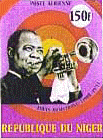 Daniel Louis Armstrong (August 4, 1901 - July 6, 1971) was a great jazz trumpet player, composer, and singer. He was nicknamed Satchmo because some people said that his mouth was like a satchel. Armstrong was born in New Orleans, Louisiana, and soon became a well-known cornet player in clubs and on riverboats along the Mississippi River. He became world famous for his incredible musical talent, especially his improvised solos. Armstrong also sang "scat," a style in which nonsense words are used in a song. Armstrong was featured in many recordings, television shows, and movies. Armstrong celebrated his birthday on July 4. Daniel Louis Armstrong (August 4, 1901 - July 6, 1971) was a great jazz trumpet player, composer, and singer. He was nicknamed Satchmo because some people said that his mouth was like a satchel. Armstrong was born in New Orleans, Louisiana, and soon became a well-known cornet player in clubs and on riverboats along the Mississippi River. He became world famous for his incredible musical talent, especially his improvised solos. Armstrong also sang "scat," a style in which nonsense words are used in a song. Armstrong was featured in many recordings, television shows, and movies. Armstrong celebrated his birthday on July 4. |
| Attucks, Crispus
Crispus Attucks (1723? - March 5, 1770) was the first American to die for the Revolutionary cause: "The first to defy, the first to die." Attucks was shot in the "Boston Massacre," the first fight leading up to the Revolutionary War. Attucks was the American son of a native African father and a woman belonging to the Natick Indian tribe. As a young adult, Attucks escaped his "owner" in Framingham, Massachusetts, and went to sea as a whaler and worked as a ropemaker in Boston, Massachusetts. He learned to read and write, and studied government. Attucks went to many anti-British meetings to discuss unfair taxes; he wrote to Governor Thomas Hutchinson (the Tory governor of Massachusetts) to protest these taxes. On March 5, 1770, Attucks and other Patriots (Colonists who were against British rule) fought with the Red Coats (British soldiers) at Dock Square in Boston in an unofficial skirmish. Attucks was the first of five people to die in the fight. The soldier who shot the Patriots were tried for murder, but most were acquitted (the future US President John Adams was the lawyer for the British soldiers); the acquittals further enraged the people of Boston. As the first person to die for the American Revolutionary cause, Attucks was buried with honor in the Park Street cemetery in Boston. "Crispus Attucks Day" was begun by black abolitionists in 1858; in 1888, the Crispus Attucks Monument was built in the Boston Common. |
Baldwin, James James Baldwin (Aug. 2, 1924-Dec. 1, 1987) was a very important American author who wrote about the struggle of being black in America. James was the oldest of nine children and was born into poverty in Harlem, New York. He spent much of his youth reading. James' mother was a domestic worker (a maid) and his strict, cruel stepfather was a factory worker and preacher (who died in a mental hospital in 1943). James was a preacher himself for three years when he was a teenager. The author Richard Wright was James' early writing mentor. Baldwin's first book, the semi-autobiographical Go Tell It On the Mountain, was published in 1953 and is considered to be a classic American novel. Baldwin lived in France for many years, distancing himself from American life in order to examine it; Baldwin wrote, "Once you find yourself in another civilization, you're forced to examine your own." A pacifist, Baldwin participated in the Southern school desegregation struggle of the 1960s and marched with Martin Luther King, Jr. Baldwin wrote extensively about the Civil Rights Movement, including The Fire Next Time and Notes of a Native Son. Throughout his life, Baldwin used his enormous writing talent to work for racial equality. Baldwin wrote, "I love America more than any other country in this world, and, exactly for this reason, I insist on the right to criticize her perpetually." and "Artists are here to disturb the peace." Baldwin died at the age of 63 at home in Saint-Paul-de-Vence, France. James Baldwin (Aug. 2, 1924-Dec. 1, 1987) was a very important American author who wrote about the struggle of being black in America. James was the oldest of nine children and was born into poverty in Harlem, New York. He spent much of his youth reading. James' mother was a domestic worker (a maid) and his strict, cruel stepfather was a factory worker and preacher (who died in a mental hospital in 1943). James was a preacher himself for three years when he was a teenager. The author Richard Wright was James' early writing mentor. Baldwin's first book, the semi-autobiographical Go Tell It On the Mountain, was published in 1953 and is considered to be a classic American novel. Baldwin lived in France for many years, distancing himself from American life in order to examine it; Baldwin wrote, "Once you find yourself in another civilization, you're forced to examine your own." A pacifist, Baldwin participated in the Southern school desegregation struggle of the 1960s and marched with Martin Luther King, Jr. Baldwin wrote extensively about the Civil Rights Movement, including The Fire Next Time and Notes of a Native Son. Throughout his life, Baldwin used his enormous writing talent to work for racial equality. Baldwin wrote, "I love America more than any other country in this world, and, exactly for this reason, I insist on the right to criticize her perpetually." and "Artists are here to disturb the peace." Baldwin died at the age of 63 at home in Saint-Paul-de-Vence, France. |
Bruce, B. K. Blanche Kelso Bruce (March 1, 1841-1898) was the first African-American who served a full term in the U.S. Senate. Senator Bruce was born a slave on the Farmville Plantation, Virginia. He was educated by his owner's son, and he later went to Oberlin Colllege (in Ohio). Bruce was a Republican senator representing Mississippi; he served from March 5, 1875 until March 3, 1881. During his term, Bruce fought for the rights of minority groups, including African-Americans, Native Americans, and Asian immigrants. After his term as senator, Bruce was appointed registrar of the treasury. He rejected an offer of a ministerial appointment to Brazil because slavery was still legal there. |
| Bluford, Guion Dr. Guion Stewart Bluford Jr. (November 22, 1942-) was the first African-American in space. A NASA astronaut, he flew aboard the Challenger Space Shuttle mission STS-8 as a mission specialist. The flight lasted from August 30, 1983, until September 5, 1983. Dr. Bluford is an aerospace engineer with a Ph.D from the Air Force Institute of Technology. He is also a colonel in the US Air Force. He later flew on other space missions, including STS-61A (in 1985), STS-39 (in 1991), and STS-53 (in 1992). In total, Bluford logged over 688 hours in space. Dr. Bluford became a NASA astronaut in August 1979. Dr. Bluford is married and has two children. |
Carver, George Washington 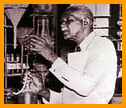 George Washington Carver (1865?-1943) was an American scientist, educator, humanitarian, and former slave. Carver developed hundreds of products from peanuts, sweet potatoes, pecans, and soybeans; his discoveries greatly improved the agricultural output and the health of Southern farmers. Before this, the only main crop in the South was cotton. The products that Carver invented included a rubber substitute, adhesives, foodstuffs, dyes, pigments, and many other products. George Washington Carver (1865?-1943) was an American scientist, educator, humanitarian, and former slave. Carver developed hundreds of products from peanuts, sweet potatoes, pecans, and soybeans; his discoveries greatly improved the agricultural output and the health of Southern farmers. Before this, the only main crop in the South was cotton. The products that Carver invented included a rubber substitute, adhesives, foodstuffs, dyes, pigments, and many other products.
For more information on Carver, click here. For a cloze (fill-in-the-blank) activity on Carver, click here. |
Chisholm, Shirley |
Douglas, Aaron Aaron Douglas (May 26, 1899 - February 3, 1979) was an African-American artist who was associated with the Harlem Renaissance art movement. Douglas was born in Topeka, Kansas, and studied art at the University of Nebraska. He later moved to Harlem, New York, and soon became a pre-eminent artist. Douglas did many paintings, woodcut prints, murals, and book and magazine illustrations. |
Douglass, Frederick 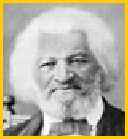 Frederick Augustus Washington Bailey Douglass (Feb. 7, 1817-Feb. 20, 1895) was an abolitionist, orator and writer who fought against slavery and for women's rights. Douglass was the first African-American citizen appointed to high ranks in the U.S. government. Frederick Augustus Washington Bailey Douglass (Feb. 7, 1817-Feb. 20, 1895) was an abolitionist, orator and writer who fought against slavery and for women's rights. Douglass was the first African-American citizen appointed to high ranks in the U.S. government.
For more information on Douglass, click here. |
Drew, Charles R. |
Dubois, W.E.B. William Edward Burghardt DuBois (February 23, 1868 - August 27, 1963) was a writer, historian, leader and one of the founders of the NAACP (National Association for the Advancement of Colored People). DuBois was born in Great Barrington, Massachusetts. He was a gifted student who became a reporter for the New York Globe when he was 15 years old. He later attended Fisk University, then transferred to Harvard University; he was the first black to receive a Ph.D. from Harvard University. DuBois became a teacher and later studied the state of black people in the USA and around the world; he wrote many books. |
Du Sable, Jean-Baptiste-Point Jean-Baptiste-Point Du Sable (1750?-1818) was a Haitian-French pioneer and trader; he founded the settlement that would later become Chicago. |
Estevanico For more information on Estevanico, click here. |
Goode, Sarah S. Sarah E. Goode was a businesswoman and inventor. Goode invented the folding cabinet bed, a space-saver that folded up against the wall into a cabinet. When folded up, it could be used as a desk, complete with compartments for stationery and writing supplies. Goode owned a furniture store in Chicago, Illinois, and invented the bed for people living in small apartments. Goode's patent was the first one obtained by an African-American woman inventor (patent #322,177, approved on July 14, 1885). |
Henson, Matthew A. 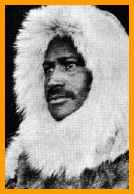 Matthew Alexander Henson (Aug. 8, 1866 - March 9, 1955) was an American explorer and one of the first people to visit the North Pole. He was on most of Robert E. Peary's expeditions, including the 1909 trip to the North Pole. Matthew Alexander Henson (Aug. 8, 1866 - March 9, 1955) was an American explorer and one of the first people to visit the North Pole. He was on most of Robert E. Peary's expeditions, including the 1909 trip to the North Pole.
|
Jemison, Mae C. 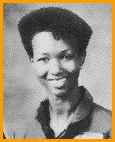 Mae C. Jemison (October 17, 1956 - ) was the first African-American woman in space. Dr. Jemison is a medical doctor and a surgeon, with engineering experience. She flew on the space shuttle Endeavor (STS-47, Spacelab-J) as the Mission Specialist; the mission lifted off on September 12, 1992 and landed on September 20, 1992. Mae C. Jemison (October 17, 1956 - ) was the first African-American woman in space. Dr. Jemison is a medical doctor and a surgeon, with engineering experience. She flew on the space shuttle Endeavor (STS-47, Spacelab-J) as the Mission Specialist; the mission lifted off on September 12, 1992 and landed on September 20, 1992.
For more information on Jemison, click here.
Go to a cloze (fill-in-the-blanks) activity on Mae Jemison.
|
Johnson, William Henry William Henry Johnson (1901- 1970) was an African-American artist who was associated with the Harlem Renaissance art movement. Johnson was born in Florence, South Carolina, but as a teenager, went to study at the National Academy of Design in New York. He painted in France from 1926 to 1930. When he returned to the USA, he opened a studio in Harlem. Johnson had his first solo art exhibition in New York in 1941. Johnson's vibrant paintings represent many subjects, ranging from scenes from everyday life to historical commemoratives of African-Americans, like Harriet Tubman, George Washington Carver, and Matthew Henson. |
Jones, James Earl James Earl Jones (January 17, 1931 -) is an African-American actor who is famous for his deep, resonant voice and powerful presence. He has acted in many movies, including Dr. Strangelove (1963) and Star Wars (as the voice of Darth Vader). He has appeared often on stage and television (including the miniseries Roots II, The Lion King, and Sesame Street). Jones was born in Arkabutla, Mississippi, and was raised by his grandparents (his parents separated before he was born). At the age of five, the family moved to Michigan. In high school, Jones overcame a severe speech impediment (a stutter that had made him almost mute for years). Jones studied at the University of Michigan, but left without a degree. He served in the miliary (as a second lieutenant). He later began acting, eventually winning two Tony awards (for acting in plays), three Emmys (for TV performances), a Grammy (for a recording in 1977) and an Oscar nomination (for movie performance). Jones now lives in New York state. |
Joplin, Scott Scott Joplin (1868-1917) was a great composer and pianist. As a boy in Texarkana, Texas, Joplin taught himself to play the piano. He played and composed ragtime music, a lively, unique genre. He composed over 60 pieces (most for piano), including the "Maple Leaf Rag" and "The Entertainer," which are still popular today. Joplin also wrote two operas. |
Jordan, Barbara Barbara Jordan (Feb. 21, 1936-Jan. 17, 1996) was the first black U.S. congresswoman from the deep South; she served Texas for six years in the US House of Representatives. Jordan was a powerful orator who fought for civil rights and the rights of the poor. |
King Jr., Martin Luther  Martin Luther King, Jr. (1929-1968) was a great man who worked for racial equality in the USA. He was born on January 15, 1929, in Atlanta, Georgia. After graduating from college and getting married, Dr. King became a minister and moved to Alabama. During the 1950's, Dr. King became active in the movement for civil rights and racial equality. He participated in the Montgomery, Alabama, bus boycott and many other peaceful demonstrations that protested the unfair treatment of African-Americans. He won the Nobel Peace Prize in 1964. Dr. King was assassinated on April 4, 1968, in Memphis, Tennessee. Commemorating the life of a tremendously important leader, we celebrate Martin Luther King Day each year in January. Martin Luther King, Jr. (1929-1968) was a great man who worked for racial equality in the USA. He was born on January 15, 1929, in Atlanta, Georgia. After graduating from college and getting married, Dr. King became a minister and moved to Alabama. During the 1950's, Dr. King became active in the movement for civil rights and racial equality. He participated in the Montgomery, Alabama, bus boycott and many other peaceful demonstrations that protested the unfair treatment of African-Americans. He won the Nobel Peace Prize in 1964. Dr. King was assassinated on April 4, 1968, in Memphis, Tennessee. Commemorating the life of a tremendously important leader, we celebrate Martin Luther King Day each year in January. |
Lawrence, Jacob Jacob Lawrence (1917-2000) was an African-American artist who was associated with the Harlem Renaissance art movement. Lawrence was born in Atlantic City, New Jersey, but at 13 years old, moved to New York City, New York, where he studied art. He soon became successful, both artistically and commercially. Lawrence often painted scenes of ordinary life in vibrant colors and with a startling angularity. In 1946, Lawrence said of his philosophy of art, "My belief is that it is most important for an artist to develop an approach and philosophy about life - if he has developed this philosophy he does not put paint on canvas, he puts himself on canvas.". |
Marshall, Thurgood 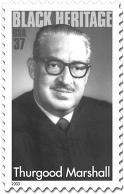 For a more on Thurgood Marshall, click here. For a Thurgood Marshall printout, click here. |
McCoy, Elijah For more information on Elijah McCoy, click here. For a cloze activity on McCoy, click here. |
Morgan, Garrett 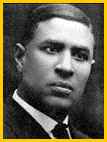 Garrett Augustus Morgan (March 4, 1877 - August 27, 1963), was an African-American inventor and businessman. He was the first person to patent a traffic signal. He also developed the gas mask (and many other inventions). Morgan used his gas mask (patent No. 1,090,936, 1914) to rescue miners who were trapped underground in a noxious mine. Soon after, Morgan was asked to produce gas masks for the US Army. Garrett Augustus Morgan (March 4, 1877 - August 27, 1963), was an African-American inventor and businessman. He was the first person to patent a traffic signal. He also developed the gas mask (and many other inventions). Morgan used his gas mask (patent No. 1,090,936, 1914) to rescue miners who were trapped underground in a noxious mine. Soon after, Morgan was asked to produce gas masks for the US Army.
For more information on Morgan, click here. |
Obama, Barack Obama graduated from Columbia University (1983), then worked as a community organizer in Chicago, Illinois. He graduated from Harvard Law School (1991) and was the first African-American president of the Harvard Law Review. Michelle Robinson and Obama married in 1992; they have 2 daughters. He was elected to the Illinois State Senate in 1996, 1998, and 2002 (he lost in 2000). Obama was elected to the US Senate in 2004 (Dem-IL). Barack has written two books, Dreams from My Father (1995) and The Audacity of Hope (2006). Obama won the Nobel Peace Prize in October, 2009. |
Owens, Jesse Go to a page on Jesse Owens. Or go to the printable version. |
Parks, Gordon |
Parks, Rosa |
Rillieux, Norbert 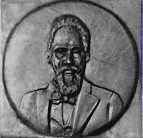 Norbert Rillieux (March 17, 1806-October 8, 1894) was an African-American inventor and engineer who invented a device that revolutionized sugar processing. Rillieux's multiple effect vacuum sugar evaporator (patented in 1864) made the processing of sugar more efficient, faster, and much safer. The resulting sugar was also superior. His apparatus was eventually adopted by sugar processing plants all around the world. Norbert Rillieux (March 17, 1806-October 8, 1894) was an African-American inventor and engineer who invented a device that revolutionized sugar processing. Rillieux's multiple effect vacuum sugar evaporator (patented in 1864) made the processing of sugar more efficient, faster, and much safer. The resulting sugar was also superior. His apparatus was eventually adopted by sugar processing plants all around the world.
|
Robinson, Jackie On April 11, 1947, Robinson played his first major league baseball game (he played for the Brooklyn Dodgers in an exhibition game against the New York Yankees). Robinson played with the Dodgers for 10 years. He played in six World Series and was the first African-American in the Baseball Hall of Fame (in 1962). For more information and activities on Robinson, click here. |
Scott, Dred |
Truth, Sojourner Sojourner Truth (1797?-1883) was an American preacher who dedicated her life to fighting for for civil and human rights. She was born a slave in New York State, but was freed in 1827. After becoming a preacher, she campaigned for the abolition of slavery and for women's rights. During the US Civil War, she helped black Union soldiers obtain supplies and also worked as a counselor for the National Freedon Relief Association. |
Tubman, Harriet |
Walker, Madame C. J.  Madam C. J. Walker (December 23, 1867 - May 25, 1919) was an inventor, businesswoman and self-made millionaire. Sarah Breedlove McWilliams C. J. Walker was an African-American who developed many beauty and hair care products that were extremely popular. Madam Walker started her cosmetics business in 1905. Her first product was a scalp treatment that used petrolatum and sulphur. She added Madam to her name and began selling her new "Walker System" door-to-door. Walker soon added new cosmetic products to her line. The products were very successful and she soon had many saleswomen, called "Walker Agents," who sold her products door to door and to beauty salons. Madam C. J. Walker (December 23, 1867 - May 25, 1919) was an inventor, businesswoman and self-made millionaire. Sarah Breedlove McWilliams C. J. Walker was an African-American who developed many beauty and hair care products that were extremely popular. Madam Walker started her cosmetics business in 1905. Her first product was a scalp treatment that used petrolatum and sulphur. She added Madam to her name and began selling her new "Walker System" door-to-door. Walker soon added new cosmetic products to her line. The products were very successful and she soon had many saleswomen, called "Walker Agents," who sold her products door to door and to beauty salons.
|
Walker, Maggie Lena Maggie Lena Walker (July 15, 1867-December 15, 1934) was the first woman in the USA to become a local bank president. Throughout her life, Walker worked for civil rights and other humanitarian causes. Maggie Mitchell was born in Richmond, Virginia, to former slaves. In 1886, Maggie married Armstead Walker, Jr. She worked first as a teacher, and then as an agent for the Woman's Union Insurance Company, quickly rising to become the executive secretary/treasurer of the company. She founded the newspaper, the St. Luke Herald, in 1902. In 1903, she started the St. Luke Penny Savings Bank and was its president. In 1929, at the start of the economic depression, her bank bought all the local black-owned banks in town and renamed itself the Consolidated Bank and Trust Company. For more information on Maggie Lena Walker, click here. For a cloze (fill-in-the-blanks) activity on Maggie Lena Walker, click here. |
Washington, Booker T. |
Related Pages:
 African-American History |
Timeline of African-American History (with quiz/printout) |
Black History Calendar |
Printable African-American Biography Worksheets Printable worksheets on many historic African-American notables, with information to read, a picture to color, and questions to answer. |
Find an Important African-American for Each Letter See if you can think of and write down an important African-American from history for each letter of the alphabet. Find a person's name for as many letters as you can. Or go to a sample answer page. |
African Americans A Printable Activity Book for Early Readers |
African Americans A Printable Activity Book for Fluent Readers |
Quiz on Great African-Americans A printable page |
African-American Inventors A printable page |
Enchanted Learning®
Over 35,000 Web Pages
Sample Pages for Prospective Subscribers, or click below
|
Overview of Site What's New Enchanted Learning Home Monthly Activity Calendar Books to Print Site Index K-3 Crafts K-3 Themes Little Explorers Picture dictionary PreK/K Activities Rebus Rhymes Stories Writing Cloze Activities Essay Topics Newspaper Writing Activities Parts of Speech Fiction The Test of Time
|
Biology Animal Printouts Biology Label Printouts Biomes Birds Butterflies Dinosaurs Food Chain Human Anatomy Mammals Plants Rainforests Sharks Whales Physical Sciences: K-12 Astronomy The Earth Geology Hurricanes Landforms Oceans Tsunami Volcano |
Languages Dutch French German Italian Japanese (Romaji) Portuguese Spanish Swedish Geography/History Explorers Flags Geography Inventors US History Other Topics Art and Artists Calendars College Finder Crafts Graphic Organizers Label Me! Printouts Math Music Word Wheels |
Click to read our Privacy Policy
| Search the Enchanted Learning website for: |